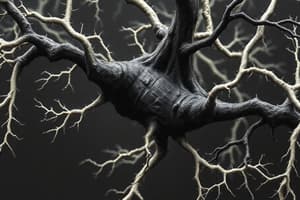Podcast
Questions and Answers
Hvað gerist þegar Na+ göngin opnast um leið og boðspennuþröskuldi er náð?
Hvað gerist þegar Na+ göngin opnast um leið og boðspennuþröskuldi er náð?
- Na+ jónir streymir inn í frumuna. (correct)
- K+ jónir hreyfast inn í frumuna.
- Himnuspennan eykst jafnt og þétt.
- Himnuspennan fer undir -70 mV.
Hvenær opnast K+ göngin í frumusímanum?
Hvenær opnast K+ göngin í frumusímanum?
- Við hámark himnuspennunnar.
- Þegar himnuspennan fellur undir -70 mV.
- Um leið og Na+ göngin lokast. (correct)
- Strax eftir afskautun frumusímans.
Hvað gerist við himnuspennuna eftir að K+ jónir flæða út úr frumunni?
Hvað gerist við himnuspennuna eftir að K+ jónir flæða út úr frumunni?
- Hún leiðir til hærri himnuspennu.
- Hún fer undir -70 mV um tíma. (correct)
- Hún breytist strax í +40 mV.
- Hún breytist ekki að neinu leyti.
Hvað lýsir best lögmálinu um „Allt eða ekkert“ í tengslum við boðspennu?
Hvað lýsir best lögmálinu um „Allt eða ekkert“ í tengslum við boðspennu?
Hvers vegna virðist boðspennan 'hoppa' í mýldum símum?
Hvers vegna virðist boðspennan 'hoppa' í mýldum símum?
Hvað er hvíldarspenna taugafrumu almennt að verulegu leyti?
Hvað er hvíldarspenna taugafrumu almennt að verulegu leyti?
Hver er aðalhlutverkið fyrir hreyfitaugafrumur?
Hver er aðalhlutverkið fyrir hreyfitaugafrumur?
Hvað gerist við afskautun taugafrumu?
Hvað gerist við afskautun taugafrumu?
Hvers vegna eru Natríumjónir (Na+) mikilvægar fyrir boðspennu?
Hvers vegna eru Natríumjónir (Na+) mikilvægar fyrir boðspennu?
Hvað er boðspenna?
Hvað er boðspenna?
Hver er megin munurinn á katjónum og anjónum?
Hver er megin munurinn á katjónum og anjónum?
Hvað er jónagöng?
Hvað er jónagöng?
Hvað stjórnar himnuspennu almennt?
Hvað stjórnar himnuspennu almennt?
Hver er hlutverk rafstöðuþrýstings?
Hver er hlutverk rafstöðuþrýstings?
Hver er efni sem mýelínslíður er aðallega samsett úr?
Hver er efni sem mýelínslíður er aðallega samsett úr?
Flashcards
Taugafrumuviðráð
Taugafrumuviðráð
Skiptir í skyntaugafrumur, hreyfitaugafrumur og millifrumur, sem samþætta boðin til að framkvæma virkni.
Samdráttarviðbragð
Samdráttarviðbragð
Einföld virkni sem tengir skyntaugafrumur, millifrumur og hreyfitaugafrumur til að framkvæma hreyfingar sem svara stimuli.
Himnuspenna
Himnuspenna
Rafhleðsla á frumuhimnunni, sem er munur á rafspennu utan og innan frumunnar.
Hvíldarspenna
Hvíldarspenna
Signup and view all the flashcards
Afskautun
Afskautun
Signup and view all the flashcards
Ofskautun
Ofskautun
Signup and view all the flashcards
Boðspenna
Boðspenna
Signup and view all the flashcards
Boðspennuþröskuldur
Boðspennuþröskuldur
Signup and view all the flashcards
Jónagöng
Jónagöng
Signup and view all the flashcards
Spennuháð jónagöng
Spennuháð jónagöng
Signup and view all the flashcards
Natríum-kalíum flutningur
Natríum-kalíum flutningur
Signup and view all the flashcards
Boðspennuþröskuldur
Boðspennuþröskuldur
Signup and view all the flashcards
Natríumgöng
Natríumgöng
Signup and view all the flashcards
Potientsbreyting
Potientsbreyting
Signup and view all the flashcards
K+ göng
K+ göng
Signup and view all the flashcards
All-or-None lögmál
All-or-None lögmál
Signup and view all the flashcards
Hraðalögmál
Hraðalögmál
Signup and view all the flashcards
Stökkleiðni
Stökkleiðni
Signup and view all the flashcards
Study Notes
Nervous System Cell Structure and Function
- Nervous system cells are called neurons
- Neurons communicate with each other via electrical signals
- Neurons have specific parts impacting communication
Neuron Parts and Structure
- Dendrites: Receive signals from other neurons
- Cell body (soma): Contains nucleus and other organelles
- Axon: Carries signals away from the cell body
- Myelin sheath: Insulates the axon, speeding signal transmission
- Nodes of Ranvier: Gaps in the myelin sheath
- Synaptic terminals (axon terminals): Release neurotransmitters to other neurons
- Synapse: The junction between neurons where neurotransmitters are passed
Communication Within a Neuron
- Action Potential: A rapid change in the electrical potential across the neuron membrane.
- Resting Potential: The electrical potential across the neuron membrane when it's not transmitting a signal. Typically around -70mV.
- Depolarization: The inside of the neuron becomes less negative, a shift towards zero, which leads to the action potential
- Repolarization: The inside returns to resting potential, becoming more negative
- Hyperpolarization: The inside of the neuron becomes more negative than the resting potential, a temporary dip in the potential below resting state.
- Threshold of excitation: The specific level of depolarization needed to trigger an action potential
- Ion channels: Protein channels that allow ions to pass through the membrane (ex: Na+, K+, Cl-) impacting polarization
- Sodium-Potassium pumps: Maintain the resting potential by moving Na+ out of the cell and K+ into the cell
Types of Neuron Communication
- Sensory neurons: Relay information from sensory receptors to the central nervous system.
- Motor neurons: Carry signals from the central nervous system to muscles or glands.
- Interneurons: Connect sensory and motor neurons within the central nervous system.
Reflex Arc & Withdrawal Reflex
- Reflex arc: A simple neural pathway that mediates a rapid, automatic response to a stimulus.
- Withdrawal reflex: A simple reflex in response to a painful stimulus to pull away the body part.
Conduction of Action Potential
- All-or-none law: An action potential either occurs or it doesn't. Strength does not differ.
- Rate Law: The level of stimulation will affect the frequency of action potentials
- Conduction/Propagation: Movement of the action potential along the neuron.
- Saltatory Conduction: Rapid signal transmission, specific to myelinated axons. Action potential jumps between Nodes of Ranvier, speeding up the propagation process
Summary of Action Potential
- The action potential is initiated when reaching a threshold of stimulation.
- The action potential has specific steps (depolarization, repolarization, hyperpolarization).
- Sodium ions flow into the axon which triggers an action potential.
- Following Sodium's influx, Potassium channels open to return back to normal potential.
Electrochemical Gradient
- Diffusion: Movement of ions from high to low concentration
- Electrostatic pressure: Opposite charges attract, same charges repel
Factors influencing membrane potential
- Sodium, potassium, and chloride ions are primary contributors
Studying That Suits You
Use AI to generate personalized quizzes and flashcards to suit your learning preferences.




